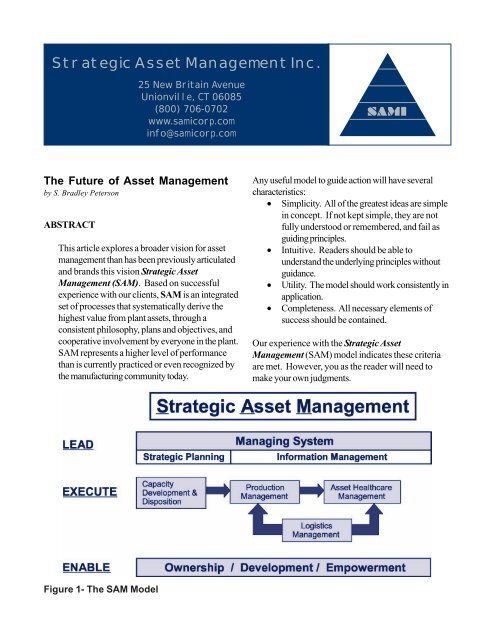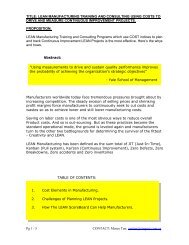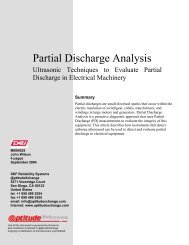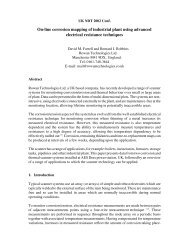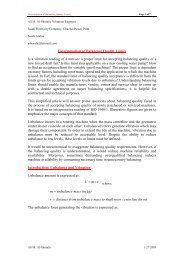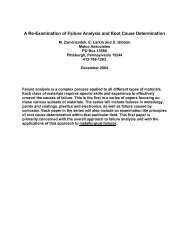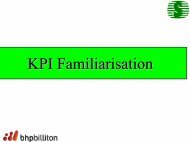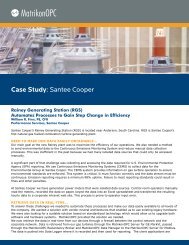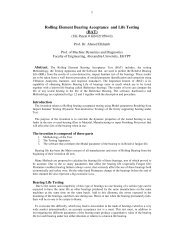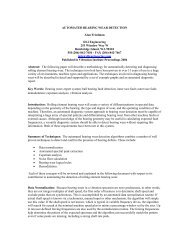Developing an Asset Management Strategy - Plant Maintenance ...
Developing an Asset Management Strategy - Plant Maintenance ...
Developing an Asset Management Strategy - Plant Maintenance ...
You also want an ePaper? Increase the reach of your titles
YUMPU automatically turns print PDFs into web optimized ePapers that Google loves.
Strategic <strong>Asset</strong> M<strong>an</strong>agement Inc.<br />
25 New Britain Avenue<br />
Unionville, CT 06085<br />
(800) 706-0702<br />
www.samicorp.com<br />
info@samicorp.com<br />
SAMI<br />
The Future of <strong>Asset</strong> M<strong>an</strong>agement<br />
by S. Bradley Peterson<br />
ABSTRACT<br />
This article explores a broader vision for asset<br />
m<strong>an</strong>agement th<strong>an</strong> has been previously articulated<br />
<strong>an</strong>d br<strong>an</strong>ds this vision Strategic <strong>Asset</strong><br />
M<strong>an</strong>agement (SAM). Based on successful<br />
experience with our clients, SAM is <strong>an</strong> integrated<br />
set of processes that systematically derive the<br />
highest value from pl<strong>an</strong>t assets, through a<br />
consistent philosophy, pl<strong>an</strong>s <strong>an</strong>d objectives, <strong>an</strong>d<br />
cooperative involvement by everyone in the pl<strong>an</strong>t.<br />
SAM represents a higher level of perform<strong>an</strong>ce<br />
th<strong>an</strong> is currently practiced or even recognized by<br />
the m<strong>an</strong>ufacturing community today.<br />
Any useful model to guide action will have several<br />
characteristics:<br />
• Simplicity. All of the greatest ideas are simple<br />
in concept. If not kept simple, they are not<br />
fully understood or remembered, <strong>an</strong>d fail as<br />
guiding principles.<br />
• Intuitive. Readers should be able to<br />
underst<strong>an</strong>d the underlying principles without<br />
guid<strong>an</strong>ce.<br />
• Utility. The model should work consistently in<br />
application.<br />
• Completeness. All necessary elements of<br />
success should be contained.<br />
Our experience with the Strategic <strong>Asset</strong><br />
M<strong>an</strong>agement (SAM) model indicates these criteria<br />
are met. However, you as the reader will need to<br />
make your own judgments.<br />
Figure 1- The SAM Model
Strategic <strong>Asset</strong> M<strong>an</strong>agement Inc.<br />
Our description of Strategic <strong>Asset</strong> M<strong>an</strong>agement<br />
(SAM) begins with the key elements of success,<br />
namely Lead, Execute <strong>an</strong>d Enable.<br />
LEAD. There are hundreds of books written about<br />
leadership, <strong>an</strong>d each one has some valuable point to<br />
make. Frequently, though, the description is of<br />
individual leadership, <strong>an</strong>d often charismatic leadership.<br />
Leadership in the pl<strong>an</strong>t setting, in our opinion, is<br />
creating consistency of purpose <strong>an</strong>d action.<br />
M<strong>an</strong>ufacturing is a large set of complex <strong>an</strong>d<br />
interrelated systems of marketing, technology, fin<strong>an</strong>ce,<br />
hum<strong>an</strong> resources, execution functions <strong>an</strong>d equipment.<br />
Physical <strong>Asset</strong> M<strong>an</strong>agement then must take all of these<br />
into account.<br />
Putting things as simply as we c<strong>an</strong> into the SAM<br />
model, the LEAD element consists of the M<strong>an</strong>aging<br />
System, Strategic Pl<strong>an</strong>ning <strong>an</strong>d Information<br />
M<strong>an</strong>agement.<br />
M<strong>an</strong>aging System. Disciplined, aligned action is the<br />
underpinning of <strong>an</strong>y hum<strong>an</strong> endeavor. Examine <strong>an</strong>y<br />
consistently great achievement <strong>an</strong>d you will find<br />
alignment <strong>an</strong>d discipline. That is the purpose of the<br />
m<strong>an</strong>aging system. Among the elements found here are:<br />
• Top down <strong>an</strong>d cascaded goals. Goals of<br />
profitability at the comp<strong>an</strong>y level become<br />
volume <strong>an</strong>d product mix goals for the pl<strong>an</strong>t.<br />
At the unit level these become volume goals,<br />
equating to equipment availability <strong>an</strong>d product<br />
quality goals. For the operator these become<br />
daily production <strong>an</strong>d equipment surveill<strong>an</strong>ce<br />
goals. For the craftsm<strong>an</strong> they become<br />
equipment condition goals.<br />
• Pl<strong>an</strong>-Do-Review. Everything we do is a<br />
process. Take emergency mainten<strong>an</strong>ce for<br />
inst<strong>an</strong>ce. The process is: 1. get a request, 2.<br />
go do it, repeated all day long. Even a<br />
pl<strong>an</strong>ned <strong>an</strong>d scheduled job doesn’t improve<br />
the system without a review process to<br />
examine the effectiveness of the pl<strong>an</strong>, the<br />
execution of results, <strong>an</strong>d a critical<br />
underst<strong>an</strong>ding of what is happening with the<br />
equipment.<br />
• Measurement systems. Assuring that in<br />
addition to outcome (lagging) indicators, each<br />
job in the pl<strong>an</strong>t has process (leading)<br />
indicators will enable each worker to make a<br />
more positive contribution.<br />
Figure 2 The M<strong>an</strong>aging System<br />
2
• Reward systems. Each pl<strong>an</strong>t rewards<br />
behavior in subtle ways. It may promote the<br />
overbearing craftsm<strong>an</strong> to a supervisor position<br />
because “he gets people going”. We may<br />
reward equipment breakdown with money<br />
<strong>an</strong>d admiration (overtime <strong>an</strong>d “attaboys”).<br />
We may reward production achievement at<br />
<strong>an</strong>y cost to people <strong>an</strong>d asset condition. We<br />
reap what we sow, so we must be careful that<br />
our reward systems actually encourage<br />
proactive behavior. Proactive mainten<strong>an</strong>ce<br />
c<strong>an</strong>’t happen in a reactive m<strong>an</strong>aging<br />
environment.<br />
• Roles, responsibilities <strong>an</strong>d accountabilities are<br />
clear. If job expectations are not clear <strong>an</strong>d<br />
results measurable, we have muddled<br />
accountability. Fingers point in all directions,<br />
<strong>an</strong>d the blame game goes on all day. Being<br />
proactive in such a system takes more courage<br />
th<strong>an</strong> most people will risk. Clarifying jobs <strong>an</strong>d<br />
accountabilities is a leadership function.<br />
• Feedback. This is part of the Pl<strong>an</strong>-Do-<br />
Review process, but gets special emphasis.<br />
We shape behavior by giving honest feedback<br />
without punishment. Under the right<br />
circumst<strong>an</strong>ces people w<strong>an</strong>t to improve.<br />
Leadership fails if it doesn’t capture that spirit.<br />
Strategic Pl<strong>an</strong>ning. In every pl<strong>an</strong>t environment we<br />
encounter we hear the same (legitimate) complaints:<br />
“Improving mainten<strong>an</strong>ce is import<strong>an</strong>t, but we just<br />
don’t have time. We have 4 major pl<strong>an</strong>t initiatives <strong>an</strong>d<br />
5 corporate initiatives, <strong>an</strong>d don’t know how <strong>an</strong>y of<br />
them are going to get done!” Or, “Everything we do is<br />
a ‘flavor of the month’. We seem to start lots of stuff,<br />
but never finish”.<br />
How do you set a pl<strong>an</strong> that is timeless One that has<br />
approvals all the way to the top of the comp<strong>an</strong>y<br />
How do you assure you have a single initiative instead<br />
of 20 Through the act of strategic pl<strong>an</strong>ning!<br />
The product of functional strategic pl<strong>an</strong>ning is<br />
alignment around a multi-year improvement pl<strong>an</strong>.<br />
To get alignment requires more th<strong>an</strong> a few words in a<br />
book. It requires that every level of the org<strong>an</strong>ization<br />
believes the content of the pl<strong>an</strong> is the most import<strong>an</strong>t<br />
The Future Of <strong>Asset</strong> M<strong>an</strong>agement<br />
set of things the comp<strong>an</strong>y c<strong>an</strong> do with its resources.<br />
That me<strong>an</strong>s a real <strong>an</strong>d compelling business case for the<br />
senior executives. For pl<strong>an</strong>t executives it me<strong>an</strong>s<br />
working on those things which are most practical,<br />
which make a difference in daily control of the work<br />
<strong>an</strong>d reduction of vari<strong>an</strong>ce. For the staff functions it<br />
me<strong>an</strong>s <strong>an</strong> underst<strong>an</strong>ding of the support they must<br />
render to enable the pl<strong>an</strong> to be successful.<br />
The elements of the Strategic Pl<strong>an</strong> are these:<br />
1. Benchmarking the function. Where are we<br />
today What are the measures saying<br />
2. <strong>Developing</strong> a vision for the future of pl<strong>an</strong>t<br />
operations. Difficult to do, sometimes requires<br />
“Industrial tourism” to see the bigger picture,<br />
<strong>an</strong>d using outside help to underst<strong>an</strong>d what’s<br />
possible. This part has to be done right, or the<br />
pl<strong>an</strong> will fall apart. Our clients have found the<br />
Execution Tri<strong>an</strong>gles (Production, Logistics <strong>an</strong>d<br />
<strong>Asset</strong> Healthcare) to be valuable to setting the<br />
vision. See Figure 3.<br />
3. Identify Gaps. Where do we fall short of the<br />
vision<br />
4. Identify Strategies to close gaps. It would be<br />
easy to shortcut this task. But one may find<br />
that, for inst<strong>an</strong>ce, a distributed control system<br />
may be a strategy that helps with product<br />
quality, product mix direction, faster<br />
ch<strong>an</strong>geovers, <strong>an</strong>d equipment condition<br />
monitoring. So one strategy covers several<br />
gaps.<br />
5. Describe Projects to implement strategies.<br />
This c<strong>an</strong> get creative, <strong>an</strong>d will be <strong>an</strong> integrating<br />
force. For inst<strong>an</strong>ce, a pl<strong>an</strong>ning <strong>an</strong>d scheduling<br />
project may be combined with a safety<br />
improvement initiative. Preventive<br />
mainten<strong>an</strong>ce improvement may combine with<br />
<strong>an</strong> ISO calibration st<strong>an</strong>dard.<br />
6. Develop the implementation pl<strong>an</strong>. It will<br />
require resources, so don’t shortcut or lowball<br />
what the implementation will require.<br />
Remember that training won’t create new<br />
behaviors. People need to be coached for<br />
new behaviors, <strong>an</strong>d measures put in place to<br />
determine success.<br />
Copyright 2003 by Strategic <strong>Asset</strong> M<strong>an</strong>agement Inc. 3
Strategic <strong>Asset</strong> M<strong>an</strong>agement Inc.<br />
7. Develop the Business Case. By integrating the<br />
initiatives into a single Strategic Pl<strong>an</strong> we c<strong>an</strong><br />
avoid the silliness of double counting for<br />
results. Was contractor reduction due to the<br />
purchasing initiative or pl<strong>an</strong>ning <strong>an</strong>d<br />
scheduling Who cares As long as the goals<br />
for contractor reduction were met, <strong>an</strong>d we<br />
stayed within the resource guidelines we<br />
requested <strong>an</strong>d received approvals for.<br />
8. Create the implementation govern<strong>an</strong>ce<br />
structure. Pl<strong>an</strong>t leadership integrates the<br />
Strategic Pl<strong>an</strong> into the Annual Pl<strong>an</strong>ning Cycle,<br />
<strong>an</strong>d the entire M<strong>an</strong>aging System is engaged to<br />
see that the results of the Strategic Pl<strong>an</strong> have<br />
accountabilities built into the entire<br />
org<strong>an</strong>ization.<br />
Information M<strong>an</strong>agement. The good <strong>an</strong>d bad news:<br />
as of the end of the last century most pl<strong>an</strong>ts are now<br />
working with <strong>an</strong> ERP system. Initial results are<br />
typically very negative: lots of rejection of the new<br />
system as hard to use, c<strong>an</strong>’t get reports out. But<br />
slowly org<strong>an</strong>izations learn to live with <strong>an</strong>d even like the<br />
new systems.<br />
A deficiency typically find in IT is confusion regarding<br />
the difference between the system <strong>an</strong>d the tool. The<br />
system is your set of internal processes <strong>an</strong>d<br />
procedures. The tool may be the SAP PM module.<br />
When your actual work process <strong>an</strong>d methods aren’t<br />
reflected in your tool, the disconnect creates great<br />
dissatisfaction <strong>an</strong>d waste. But when integrated, there<br />
is great synergy to get information to m<strong>an</strong>age the<br />
business.<br />
• Capacity Development is usually considered<br />
to be the Design Engineering <strong>an</strong>d Project<br />
M<strong>an</strong>agement functions in <strong>an</strong> org<strong>an</strong>ization.<br />
This function consumes $100’s of millions in<br />
what are often risky bets made on optimum<br />
market assumptions. A thoughtful <strong>an</strong>d<br />
disciplined method to assure excellence in the<br />
assumptions, design, construction <strong>an</strong>d<br />
preparation for production c<strong>an</strong> be a valuable<br />
tool.<br />
• Production M<strong>an</strong>agement. Everyone in the<br />
pl<strong>an</strong>t believes with good reason that<br />
production is the reason we are all here. And<br />
indeed this is the vehicle for value creation.<br />
• Logistics include materials m<strong>an</strong>agement,<br />
purchasing <strong>an</strong>d movements of people <strong>an</strong>d<br />
materials. This function c<strong>an</strong> make or break<br />
the Production <strong>an</strong>d <strong>Asset</strong> Healthcare<br />
M<strong>an</strong>agement functions.<br />
• <strong>Asset</strong> Healthcare M<strong>an</strong>agement. Is this just<br />
<strong>an</strong>other term for mainten<strong>an</strong>ce <strong>an</strong>d reliability<br />
Perhaps at some levels it is. But it is<br />
concerned with optimizing <strong>an</strong>d integrating with<br />
all parts of the business based on risk <strong>an</strong>d<br />
value, <strong>an</strong>d so goes beyond the traditional<br />
boundaries of M&R.<br />
We have developed improvement models for<br />
Production, Logistics <strong>an</strong>d <strong>Asset</strong> Healthcare. Indeed,<br />
the <strong>Asset</strong> Healthcare model is the well-known SAMI<br />
Tri<strong>an</strong>gle, relabeled <strong>an</strong>d integrated in the context of<br />
Strategic <strong>Asset</strong> M<strong>an</strong>agement.<br />
SAMI’s method is quite simple. After the Strategic<br />
Pl<strong>an</strong>, we undertake a detailed design for one or more<br />
of the Execution functions. In that design process we<br />
assure complete alignment between the tool <strong>an</strong>d work<br />
processes, leading to a virtuous cycle of increasing<br />
underst<strong>an</strong>ding <strong>an</strong>d utility of the system.<br />
EXECUTE. Four functional areas exist in <strong>an</strong>y<br />
m<strong>an</strong>ufacturing environment. These arenas are the<br />
typical focus of leadership. If done well, they lead to<br />
functional excellence.<br />
4
The Future Of <strong>Asset</strong> M<strong>an</strong>agement<br />
Stage 5<br />
Operational Excellence<br />
<strong>Asset</strong><br />
M<strong>an</strong>agement<br />
RAM<br />
Equipment<br />
St<strong>an</strong>dardization<br />
Stage 4<br />
Engineered Reliability<br />
Life<br />
Cycle<br />
Analysis<br />
Vendor<br />
Reliability<br />
Mainten<strong>an</strong>ce/<br />
Craft Operations<br />
Flexibility Integration<br />
RCM<br />
External<br />
Benchmarking OPM<br />
Stage 3<br />
Org<strong>an</strong>izational Excellence<br />
Predictive<br />
Mainten<strong>an</strong>ce<br />
<strong>Asset</strong><br />
Healthcare<br />
Failure<br />
Analysis<br />
Stage 2<br />
Proactive Mainten<strong>an</strong>ce<br />
Condition<br />
Monitoring<br />
Craft Skills<br />
Enh<strong>an</strong>cement<br />
Equipment History<br />
Preventive<br />
Mainten<strong>an</strong>ce<br />
Work Identification/<br />
Prioritization<br />
Pl<strong>an</strong>ning<br />
& Scheduling<br />
MANAGING<br />
SYSTEM<br />
Work Execution/<br />
Review<br />
CMMS/Metrics<br />
Materials<br />
M<strong>an</strong>agement<br />
Stage 1<br />
Pl<strong>an</strong>ned<br />
Mainten<strong>an</strong>ce<br />
Figure 3: The SAMI <strong>Asset</strong> Healthcare<br />
Tri<strong>an</strong>gle<br />
Note: Please see www.samicorp.com for details of the SAMI<br />
Production <strong>an</strong>d Logistics tri<strong>an</strong>gles as well as the<br />
corresponding maturity matrices detailing the<br />
characteristics of <strong>an</strong> org<strong>an</strong>ization at each stage of the<br />
models.<br />
ENABLE. M<strong>an</strong>y programs for ch<strong>an</strong>ge are viewed as<br />
a simple matter of documenting procedures <strong>an</strong>d<br />
providing training. If these things are done, ch<strong>an</strong>ge<br />
should happen, right<br />
Wrong. Hum<strong>an</strong> nature doesn’t work that way.<br />
Prescriptive formulations may work for machinery, but<br />
(fortunately) the hum<strong>an</strong> machine is more complex!<br />
First, why do I say this is fortunate Most of our<br />
corporate clients have a large number of related but<br />
disintegrated goals. Safety, reliability improvements, 6<br />
Sigma, Le<strong>an</strong> M<strong>an</strong>ufacturing, Supply Chain<br />
rationalization, etc. These are often presented to the<br />
pl<strong>an</strong>t as a series of corporate staff visits, all requiring<br />
the pl<strong>an</strong>ts time <strong>an</strong>d attention. If the pl<strong>an</strong>t acted on the<br />
sum of these “required programs” with full gusto, they<br />
would quit producing product. Their time <strong>an</strong>d<br />
attention would be taken in team meetings, developing<br />
procedures, <strong>an</strong>d trying to rationalize the differing<br />
dem<strong>an</strong>ds of each program.<br />
Fortunately, pl<strong>an</strong>t personnel know their jobs are tied<br />
to making budgeted qu<strong>an</strong>tities of quality product. So<br />
their view of ch<strong>an</strong>ge is to ignore these directives until<br />
they evaporate from lack of momentum <strong>an</strong>d<br />
commitment. Their approach is well-rewarded; most<br />
programs do indeed get replaced by the next wave of<br />
“best practice” from corporate. I apologize to readers<br />
who have corporate development roles, as I may<br />
Copyright 2003 by Strategic <strong>Asset</strong> M<strong>an</strong>agement Inc. 5
Strategic <strong>Asset</strong> M<strong>an</strong>agement Inc.<br />
seem cynical. But in my experience the only ch<strong>an</strong>ge<br />
that lasts in the pl<strong>an</strong>t are those things that make sense<br />
to the guy on the pl<strong>an</strong>t floor. Safety, for inst<strong>an</strong>ce, is in<br />
his best interest. It may have taken a decade or more<br />
of emphasis on safety, but everywhere we go we see<br />
good results <strong>an</strong>d lasting ch<strong>an</strong>ge.<br />
Some criteria for ch<strong>an</strong>ge of <strong>an</strong>y kind to take hold in<br />
the pl<strong>an</strong>t are:<br />
1. Intellectually it makes sense to the pl<strong>an</strong>t<br />
population. That sense me<strong>an</strong>s that improved<br />
productivity will likely result from such a<br />
program.<br />
2. The pl<strong>an</strong>t population has a major say in how it<br />
will happen in their environment. They have<br />
the power, collectively, to determine whether<br />
it will proceed, <strong>an</strong>d how it will proceed.<br />
3. They see true commitment to the results. That<br />
me<strong>an</strong>s a number of things.<br />
• Some executive’s future is tied to making<br />
this happen<br />
• It has worked somewhere else that is<br />
similar enough to their environment<br />
• The leadership team are all on board, no<br />
quibbling or sidebars<br />
• Results are measured <strong>an</strong>d posted at visible<br />
locations in the pl<strong>an</strong>t<br />
• Valuable line people are assigned to the<br />
job, taken from other import<strong>an</strong>t tasks<br />
Ownership. How do we enable our work with our<br />
clients What might apply to your own org<strong>an</strong>ization<br />
Leadership Consensus to Proceed. SAMI won’t<br />
proceed with billable work unless <strong>an</strong>d until we know<br />
our client’s leadership team, at the appropriate level,<br />
has consensus to proceed. Sometimes that me<strong>an</strong>s<br />
refusing <strong>an</strong> order for services from a pl<strong>an</strong>t m<strong>an</strong>ager,<br />
for inst<strong>an</strong>ce, if we don’t think the operations m<strong>an</strong>ager<br />
is fully supportive. To accept work under these<br />
conditions violates a cardinal rule, namely: Anyone<br />
who has not been consulted does not feel he has to<br />
support the decision. No matter how assured the<br />
person at the top of the org<strong>an</strong>ization is that the group<br />
will follow his decision, our experience is that lack of<br />
commitment by the entire leadership team is the<br />
number one cause of failure for improvement<br />
initiatives.<br />
Worker Consensus to Proceed. We usually begin<br />
our client engagements with a baseline assessment of<br />
current processes, practices <strong>an</strong>d results. Our clients<br />
typically believe this is because we need the data to<br />
know how to improve. The more import<strong>an</strong>t reason by<br />
far, however, is to engage the org<strong>an</strong>ization in a<br />
decision-making process that includes representation<br />
from all areas. Our assessments are designed to touch<br />
the greatest number of people practical, to solicit from<br />
them their issues, ideas <strong>an</strong>d experience. There is <strong>an</strong><br />
interesting pattern we almost always see. Leadership<br />
w<strong>an</strong>ts us to get the hourly workers to be willing to<br />
ch<strong>an</strong>ge; the hourly workers in turn challenge leadership<br />
to do its job <strong>an</strong>d lead with strength of purpose,<br />
consistency <strong>an</strong>d with high st<strong>an</strong>dards. The assessment<br />
process brings their views together, enabling them to<br />
see they w<strong>an</strong>t the same results: a productive, safe <strong>an</strong>d<br />
competitive workplace where people are valued.<br />
Develop a Workable Process <strong>an</strong>d Passionate<br />
Owners. Virtually every engagement we participate in<br />
has a work process design phase. The designers,<br />
typically a team of 8-10 part-time people, represent all<br />
types of jobs <strong>an</strong>d all levels of the org<strong>an</strong>ization. We<br />
ask for leaders, even if those leaders c<strong>an</strong> be negative<br />
at times. This team goes through the forming,<br />
storming, norming <strong>an</strong>d performing stages of<br />
development, <strong>an</strong>d we are careful to prepare them for<br />
the “J” curve effect (they go down emotionally before<br />
they go up). Their product is a completely thought out<br />
work m<strong>an</strong>agement process, with all the details that will<br />
enable it to work in their environment. Our experience<br />
is that the product is 95% the same as virtually <strong>an</strong>y<br />
other pl<strong>an</strong>t’s. The 5% difference is critical, though, in<br />
practical workability. But the most import<strong>an</strong>t result of<br />
the design is a team of people who see the future <strong>an</strong>d<br />
are passionate about making that future happen.<br />
Client-Driven Implementation. Only when<br />
workers see peers passionate about ch<strong>an</strong>ge will they<br />
pay attention. Outsiders (consult<strong>an</strong>ts) are seen as<br />
nuis<strong>an</strong>ces to be avoided. But if your respected peer is<br />
deeply committed to a new method of work, you will<br />
pay attention. And if he is willing to risk your<br />
6
elationship by making it not-optional, then you will<br />
believe it is a worthy ch<strong>an</strong>ge. Our consult<strong>an</strong>ts support<br />
the client in making the ch<strong>an</strong>ges, not the other way<br />
around.<br />
You may note that most of SAM description thus far is<br />
about enabling ch<strong>an</strong>ge, not about the core<br />
mainten<strong>an</strong>ce or production process. We assure that<br />
we have qualified experts in the work processes on<br />
the teams. Our clients seldom fail because they don’t<br />
underst<strong>an</strong>d best practices, but because they c<strong>an</strong>’t get<br />
them implemented. We have learned to focus on<br />
ch<strong>an</strong>ge because it is the critical barrier for success!<br />
Development. It is possible that your people c<strong>an</strong><br />
work at much higher levels th<strong>an</strong> they are today. In a<br />
reactive environment vs. a proactive environment these<br />
are frequent roles:<br />
The Future Of <strong>Asset</strong> M<strong>an</strong>agement<br />
Empowerment. The “E” word has lots of bad<br />
connotations from the failures of quality programs in<br />
the 80’s <strong>an</strong>d early 90’s. The popular method of<br />
empowerment was a week’s worth of training in “soft<br />
skills”, <strong>an</strong>d <strong>an</strong> admonition that they should step up <strong>an</strong>d<br />
be their own bosses. The result was lack of direction,<br />
<strong>an</strong>ger, disempowered supervisors <strong>an</strong>d m<strong>an</strong>agement,<br />
<strong>an</strong>d a decrease in productivity. Lee Solomon, founder<br />
of Solomon Associates who benchmark most of the<br />
world’s refineries, once told me: “There is a high,<br />
negative correlation between implementation of<br />
self-m<strong>an</strong>aged work teams <strong>an</strong>d perform<strong>an</strong>ce”.<br />
Empowerment as implemented not only didn’t work,<br />
but it made things worse.<br />
What is empowerment It is enabling a worker to do<br />
more, <strong>an</strong>d to take responsibility for his own<br />
perform<strong>an</strong>ce. How c<strong>an</strong> this best be done First, by<br />
Job/Role Reactive Environment Proactive Environment<br />
Craftsm<strong>an</strong> Component Replacer Troubleshooter/RCF <strong>an</strong>alyzer<br />
Operator Victim, Problem Identifier Proactive Worker, Minor Mainten<strong>an</strong>ce<br />
Supervisor Expeditor Work enabler, coordinator, troubleshooter<br />
Engineer Troubleshooter Equipment defect elimination/optimization<br />
Ch<strong>an</strong>ging these roles is partially a matter of removing<br />
obstacles to being proactive <strong>an</strong>d clarifying<br />
expectations, roles <strong>an</strong>d responsibilities. But to a<br />
signific<strong>an</strong>t extent there is a requirement to assist people<br />
to be able to fill new roles. This requires training, but<br />
much more th<strong>an</strong> training. It involves coaching <strong>an</strong>d<br />
testing the limits of the individuals in the job. Some<br />
operators are mech<strong>an</strong>ically inclined, <strong>an</strong>d some are not.<br />
Some will be eager to take on new roles, <strong>an</strong>d some<br />
very resist<strong>an</strong>t. Development takes time <strong>an</strong>d energy for<br />
a supervisor to underst<strong>an</strong>d what is possible, <strong>an</strong>d work<br />
with each of his people on a specific development<br />
program, customized to the specific task, <strong>an</strong>d the<br />
native abilities of the worker. A training org<strong>an</strong>ization<br />
c<strong>an</strong> be invaluable here, but the task c<strong>an</strong>not be<br />
delegated. The approach must be rifle shots, not<br />
gr<strong>an</strong>diose, one-size-fits-all programs.<br />
having a disciplined <strong>an</strong>d well defined system to follow,<br />
<strong>an</strong>d enabling the worker to be successful in the context<br />
of the system. Next, is to develop the worker to be<br />
successful in <strong>an</strong> exp<strong>an</strong>ded role. Finally, we give the<br />
worker the tools to underst<strong>an</strong>d whether he is<br />
mastering the job. This includes measures, feedback,<br />
coaching <strong>an</strong>d encouragement. Empowerment is the<br />
result of a disciplined system of work, not a<br />
prerequisite.<br />
Results. Leadership alignment around the strategic<br />
direction of the org<strong>an</strong>ization may be the single most<br />
import<strong>an</strong>t result of implementing the SAM model. This<br />
cohesiveness within <strong>an</strong> org<strong>an</strong>ization will certainly lead<br />
to fin<strong>an</strong>cial results as well. These results are still being<br />
documented. However, SAMI clients have achieved<br />
benefits in excess of $100M within a short period of<br />
time by taking a strategic approach to operations<br />
excellence. The chart below depicts <strong>an</strong> actual cost/<br />
Copyright 2003 by Strategic <strong>Asset</strong> M<strong>an</strong>agement Inc. 7
Strategic <strong>Asset</strong> M<strong>an</strong>agement Inc.<br />
Cummulative Cost/Benefit for Implementing Strategic Pl<strong>an</strong><br />
Note: Gross Capacity evaluated @ $10/BEQ Margin<br />
250.0<br />
200.0<br />
<br />
$MM<br />
150.0<br />
100.0<br />
50.0<br />
0.0<br />
FY02<br />
FY03<br />
FY07<br />
-50.0<br />
FY04<br />
FY05<br />
FY06<br />
Gross Capacity Gross Efficiency Cost<br />
benefit <strong>an</strong>alysis detailing fin<strong>an</strong>cial benefits from<br />
increased efficiency <strong>an</strong>d increased pl<strong>an</strong>t capacity<br />
versus the costs of implementing the SAM model over<br />
a period of a number of years.<br />
Figure 4: SAM Cost/Benefit Analysis<br />
SUMMARY<br />
Strategic <strong>Asset</strong> M<strong>an</strong>agement is the systematic<br />
process that enables the dream of Operations<br />
Excellence. It emphasizes a logical approach to best<br />
practices through the developmental stages of the<br />
EXECUTE Tri<strong>an</strong>gles. Functional excellence will never<br />
be enough, however, to be the best. LEAD functions<br />
are the glue that bring all the pieces together in <strong>an</strong><br />
optimized set of systems, especially through the<br />
mech<strong>an</strong>ism of the M<strong>an</strong>aging System <strong>an</strong>d Strategic<br />
Pl<strong>an</strong>. Finally, we c<strong>an</strong> only be as successful as our<br />
workers’ endorsement <strong>an</strong>d participation in these<br />
functional excellence practices. We must ENABLE<br />
our people to bring us the success we all desire.<br />
We are able to become the best if we start our journey<br />
with the right model.<br />
8


